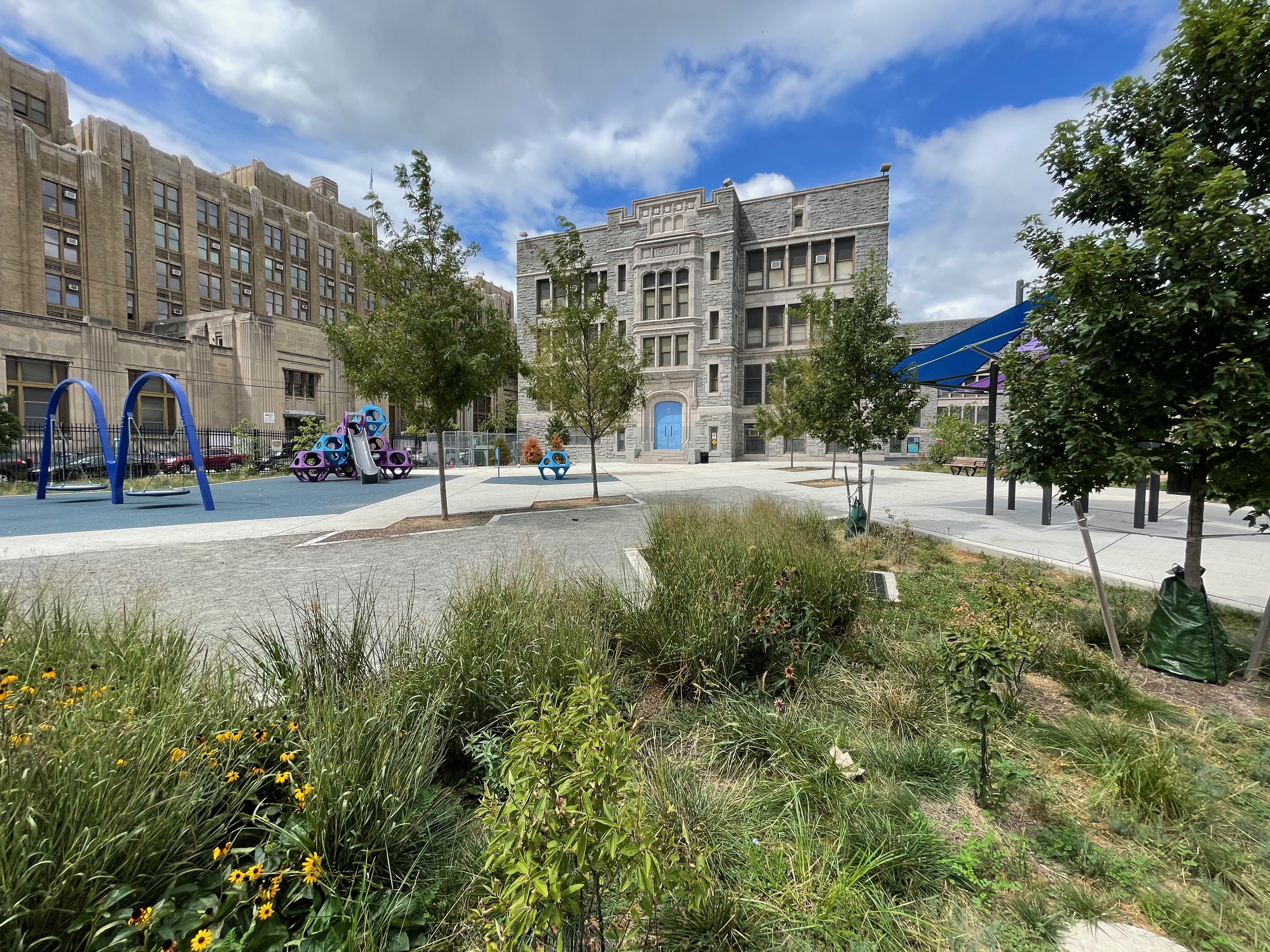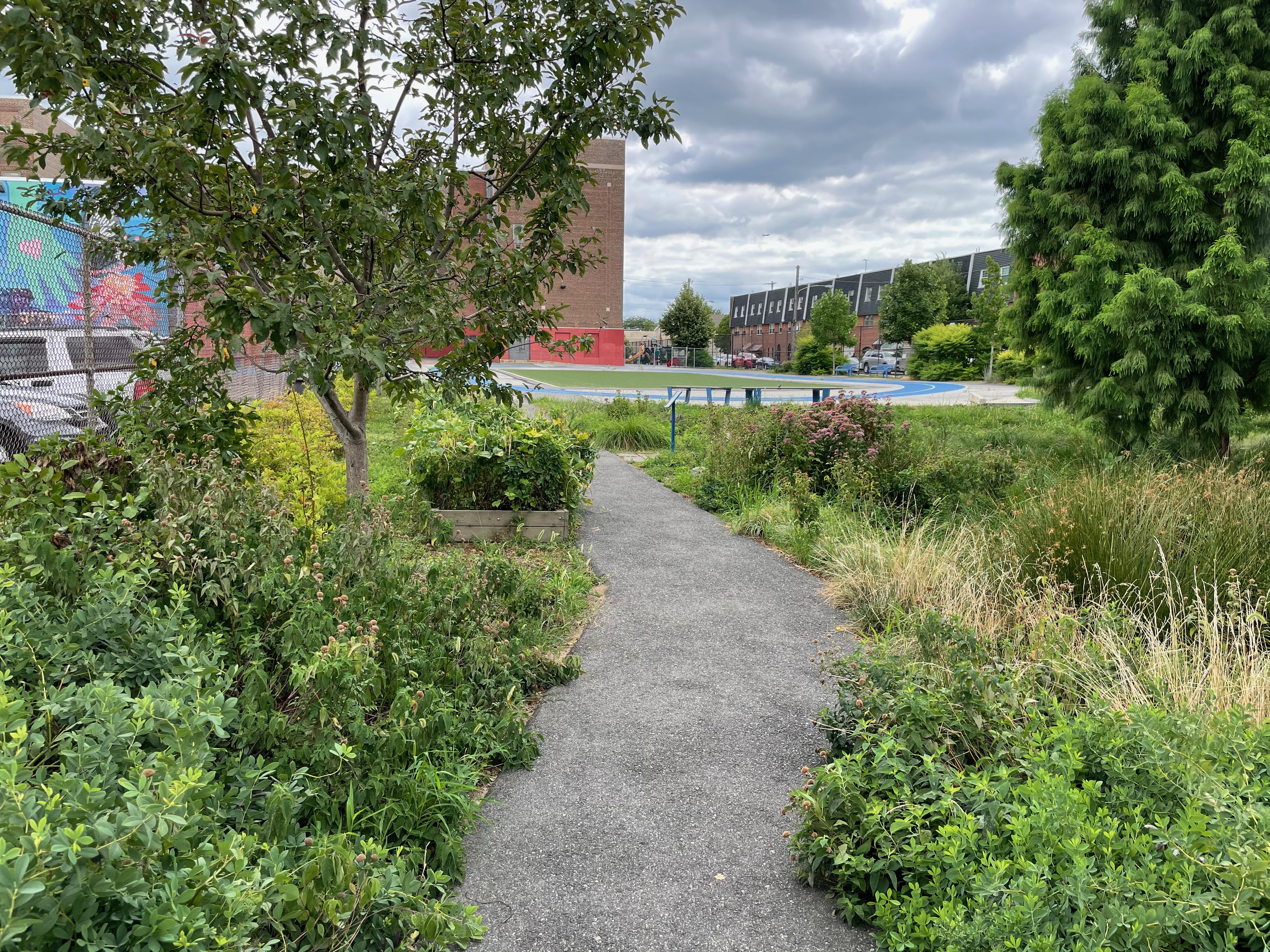
John H. Taggart Elementary School – one of this year's 13 honorees.
In schools across the city, we’re planting seeds for a greener, cleaner tomorrow.
Designed to reduce waterway pollution while beautifying our communities, green stormwater infrastructure (GSI) systems are integrated into the landscape of Philadelphia schoolyards—and curriculums—every year.
Since 2014, we have recognized Stormwater Pioneers, honoring the best in stormwater management on private property.
This year, we are giving the 2021 Stormwater Pioneers Award to the School District of Philadelphia for their leadership and commitment to GSI maintenance for 13 Stormwater Grant-funded projects. For these schoolyard projects, the School District of Philadelphia has demonstrated exceptional commitment to maintenance, education, and community engagement around green stormwater infrastructure.
Several of the GSI schoolyard projects honored this year were made possible through implementation by the Trust for Public Land (TPL) with funding by TPL, the School District, and Stormwater Grants from the Water Department. These schools include William Cramp Elementary School, John H. Taggart Elementary School, Adaire Elementary School, Edward M. Stanton School, JM Patterson School, William Dick School, and Southwark School.
School group partners, including Friends of Chester A. Arthur and the West Philly Coalition for Neighborhood Schools for the Lea School, also received Stormwater Grants and partnered with the School District to build GSI within their respective schoolyards.
“We wanted to recognize the School District as a Stormwater Pioneer not only because we have developed a strong partnership with staff to build new GSI projects on schoolyards, but also because they have prioritized maintenance at existing sites,” says Beth Anne Lutes, Stormwater Billing and Incentives manager. “Maintaining GSI systems is crucial to the success of Green City, Clean Waters, and the School District of Philadelphia has proven their commitment to the success of a project throughout its entire lifecycle, while also educating the students and communities about the importance of stormwater management and maintenance.”
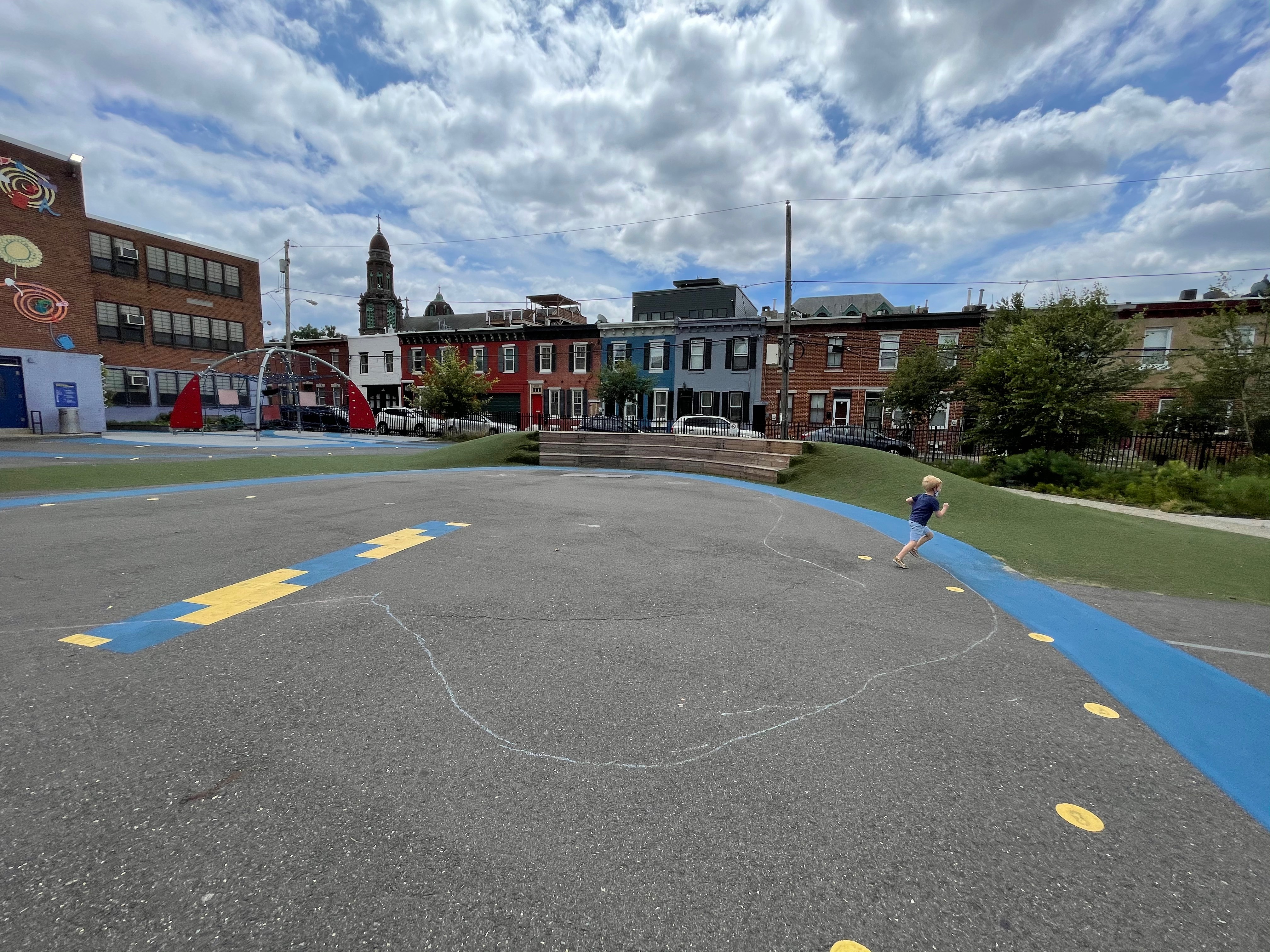
Chester Arthur School – one of this year's 13 honorees.
Since the start of Green City, Clean Waters 10 years ago, the School District of Philadelphia has been a fundamental partner in the 25-year plan to improve local waterway health using primarily green stormwater systems backed by investments in traditional infrastructure.
All 13 schools voluntarily received green stormwater infrastructure through the Water Department’s Stormwater Grants Program, which helps fund the design and construction of stormwater retrofit projects on non-residential properties in Philadelphia. Stormwater retrofit projects provide an opportunity for new landscaping, improved drainage, and beautified properties. Properties also qualify for lower stormwater charges on their monthly bill through the Stormwater Credits Program.
“As one of the largest landowners in the City, we are located in every community in the city,” says Emma Melvin, Green Infrastructure Program Manager for the School District's Office of Capital Programs. “Our schools are ideal to raise awareness and showcase green infrastructure because we engage so many stakeholders in the community. We have students, teachers, parents—they all engage on school campuses.”
The green spaces, located on nearly 40 public school campuses, inspire lessons both outside and inside classrooms.
“If there is green infrastructure being created in the schoolyard, why not connect what’s going on in the classroom with what’s going on outside?” says Ellen Schultz, Director of Education Partnerships at the Water Department’s Fairmount Water Works Interpretive Center. “It shouldn’t be siloed.”
A Longstanding Partnership
In her role at the Fairmount Water Works Interpretive Center, Schultz has been integrally involved in developing educational programs for Philadelphia students since 2004.
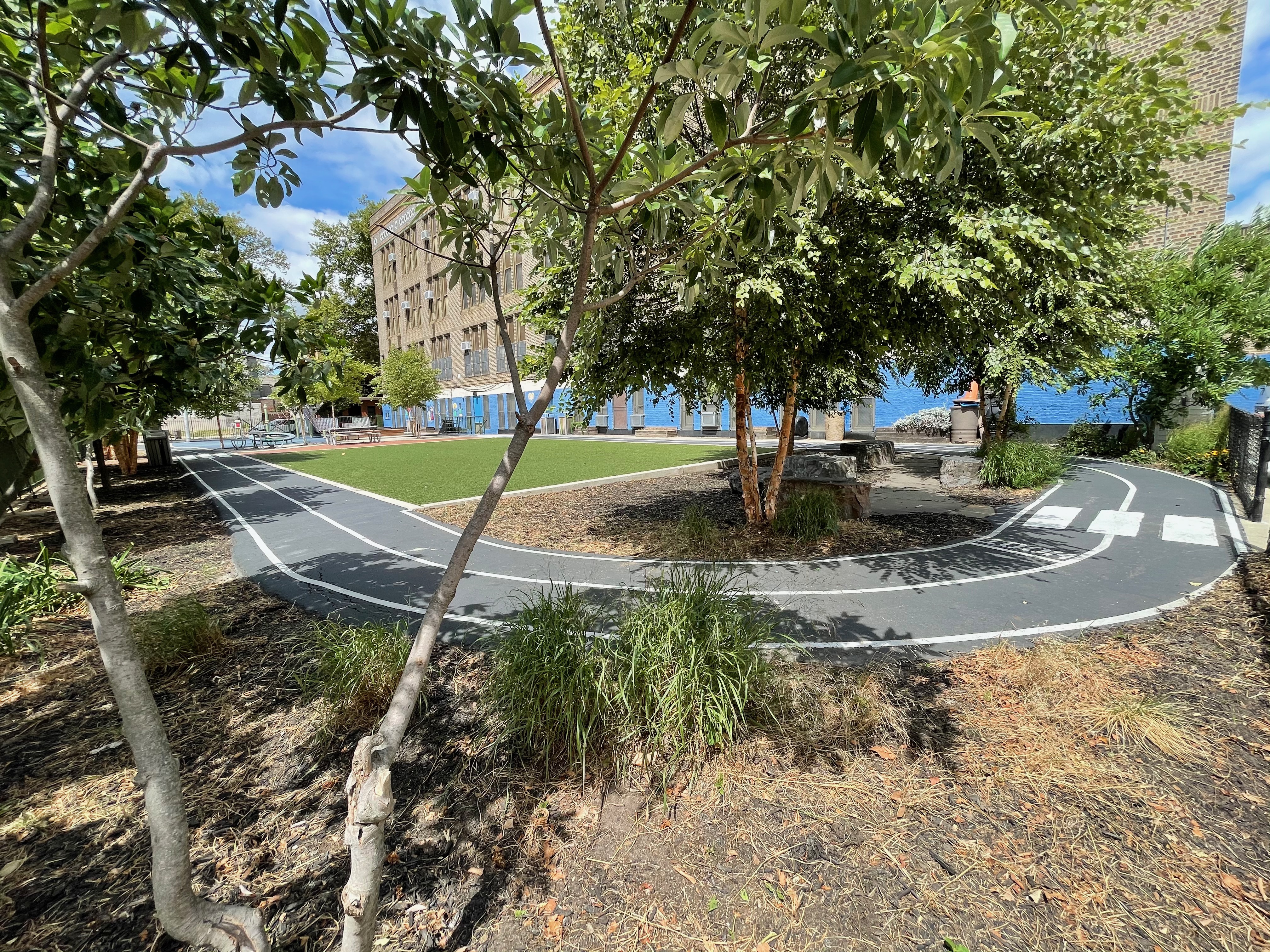
Edwin M. Stanton School – one of this year's 13 honorees.
Through Green City, Clean Waters, the Water Department collaborated in 2014 with the School District of Philadelphia and the Fairmount Water Works Interpretive Center to develop the Understanding the Urban Watershed curriculum guide. The resource was designed to educate middle school students on topics such as drinking water, wastewater, stormwater, and watershed stewardship.
Shortly after, in 2015, the School District recruited its first Sustainability Manager, Megan Garner, who helped further advance the Water Department and School District’s partnership.
The School District of Philadelphia began its sustainability plan, “GreenFutures,” in 2016. GreenFutures encompasses five areas of focus: efficiencies, engagement, equity, environment, and education, with goals set over a five-year period.
“It’s a five-year sustainability plan created by district staff and stakeholders with the common goal to make public schools great,” Garner says. “The plan aims to make every school a greener school that will better serve our students and communities. A major objective included bridging the gap between green school operations and sustainability education, which naturally aligned with the School District’s already established partnership with Green City, Clean Waters.”
“It was really a group effort to get the first projects off the ground,” Melvin says. “PWD supported the school district immensely to reimagine what our schoolyards could look like with green infrastructure and how to engage students and teachers in their schoolyards and thinking how greening can be incorporated into the learning process.”
There are currently 38 schools with GSI, with a goal to add five more every year.
“Everybody knows that children learn better with this connection to nature,” Garner says. “And, honestly, what better way to learn about things, if we want students to have systems thinking and to have critical thinking, than to provide that real-world experience in a natural system or in a green stormwater infrastructure system? It just makes sense.”
2021 Noteworthy Pioneers
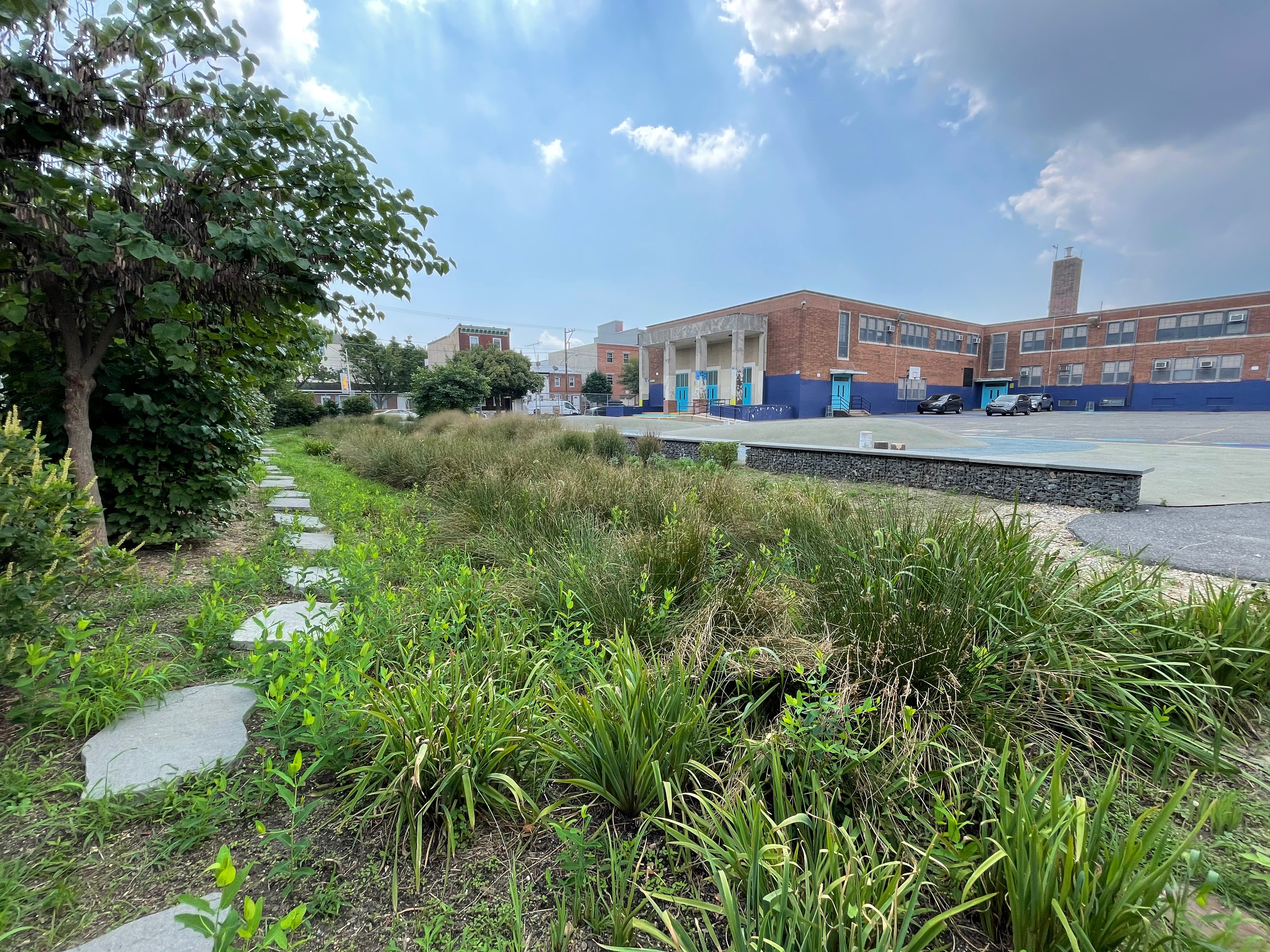
Alexander Adaire Elementary – one of this year's 13 honorees.
For this year’s Stormwater Pioneers, GSI is inspiring hands-on education.
In Alexander Adaire Elementary School in Fishtown, a lesson around the history of water was tied into students’ involvement in the maintenance of stormwater management systems. Because plants were being trampled and soil compacted, the school’s rain garden was relocated. The design for the new rain garden was created with parent and community involvement.
“It’s really great to see after (the GSI) is built, a lot of them link to the curriculum, to the classroom and activities outside and continuing that,” says Stephanie Chiorean, PWD schools program partnership specialist. “I think a lot of those activities are typically related to learning but then also the stewardship side really can help reinforce some of those learning activities themselves.”
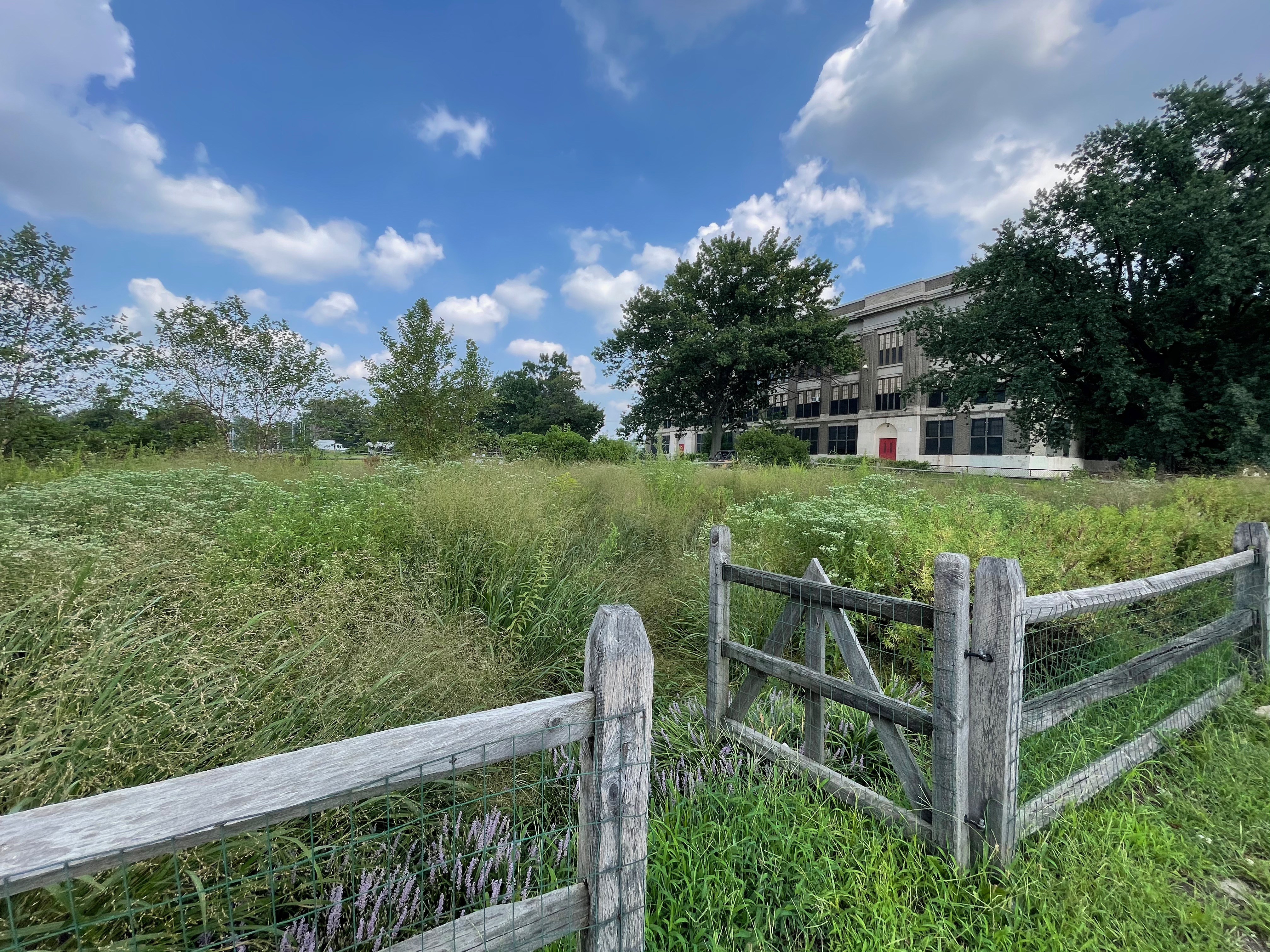
Warren G. Harding Middle School – one of this year's 13 honorees.
In the Frankford-based Warren G. Harding Middle School, Bryn Mawr College students are working with classes to model sensors for measuring precipitation in rain gardens.
“This really shows how our curriculum is a living, breathing thing,” Schultz says.
The green systems at Southwark School in South Philadelphia demonstrate the value of community engagement.
There was a connection between the teaching units about water and the GSI improvements that were made. There was also strong parent and community involvement in the upgrades to the outdoor physical space, including several “visioning” sessions. Parents, teachers, and students were all involved in the process and remained involved in the maintenance of the GSI.
William Cramp School, located in the Fairhill section of Philadelphia, received sensors for air quality and soil moisture. The new schoolyard development, including GSI, helped cultivate community engagement.
“Through the process of the design and the engagement with the community, it really created this culture at the school of inclusiveness and interest and engagement with the parents,” Garner says. “Now, it’s continually used by the community, so I think it really says a lot about the type of work that goes with the development of these green stormwater infrastructure projects because it really brings the community in and creates that authentic culture. It’s not this forced situation. It really brings them in and creates ownership and stewardship.”
And Congrats to our other Pioneers + Pupils!
Here are the 13 schools being recognized as the 2021 Stormwater Pioneers:
Each Greened Acre soaks up a SEPTA bus-sized (+27,000-gallon) load of polluted runoff during a 1.5-inch storm.
Chester A. Arthur School, 2000 Catharine St
- Grant Funding: $232,000
- Greened Acres: 1.02 GA
- Green Infrastructure: Porous pavement, rain garden, subsurface basin
Henry C. Lea Elementary School, 4700 Locust St
- Grant Funding: $302,000
- Greened Acres: 1.96 GA
- Green Infrastructure: 5 rain gardens, 2 subsurface basins, porous pavers
Martin Luther King High School, 6100 Stenton Ave
- Grant Funding: $763,282
- Greened Acres: 3.81 GA
- Green Infrastructure: 4 Rain gardens, 1 subsurface basin
William Dick School, 2498 W Diamond St
- Greened Acres: 3.36 GA
- Green Infrastructure: Rain garden, tree trench, and Infiltration Storage Trench
Mayfair Elementary School, 3001 Princeton Ave
- Grant Funding: $707,015
- Green Acres: 4.78 GA
- Green Infrastructure: 3 Rain gardens
John M. Patterson School, 7000 Buist Ave
- Grant Funding: $159,000
- Greened Acres: 0.76 GA
- Green Infrastructure: Depaving, rain gardens, porous pavers
John H. Taggart Elementary School, 400 W Porter St
- Grant Funding: $116,000
- Greened Acres: 0.93 GA
- Green Infrastructure: depaving, subsurface basin, rain garden
Edwin M. Stanton School, 901 S 17th St.
- Grant Funding: $67,550
- Greened Acres: 0.14 GA
- Green Infrastructure: Depaving
Motivation High School, 5900 Baltimore Ave
- Grant Funding: $321,000
- Greened Acres: 2.07 GA
- Greene Infrastructure: Depaving, Rain Garden
Adaire Elementary School, 1300 E Palmer St
- Grant Funding: $650,188
- Greened Acres: 2.30 GA
- Green Infrastructure: Rain garden
Harding Middle School, 2000 Wakeling St
- Grant Funding: $511,922
- Greened Acres: 3.11
- Green Infrastructure: 3 rain gardens
Southwark School, 1835 S 9th St.
- Grant Funding: $217,337
- Greened Acres: 0.99 GA
- Green Infrastructure: Rain garden, porous paving, depaving
Cramp School, 3449 N Mascher St
- Grant Funding: $15,659
- Greened Acres: 0.17 GA
- Green Infrastructure: Depaving
